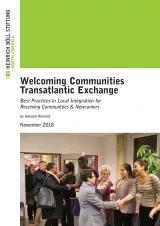Best Practices in Local Integration for Receiving Communities & Newcomers
In 2015, the international community began to grasp the historic scale of global displacement and migration. By the end of that year, more than 60 million people had been forcibly displaced—a population approximately the size of Italy or the United Kingdom, larger than at any other time in history. Among the largest displaced populations were nationals from Syria, Afghanistan, Colombia, Congo, Iraq, Nigeria, Somalia, Sudan, South Sudan, and Yemen, and many desperately sought to make their way to Europe. In August 2015, more than 130,000 people arrived in Europe by land and sea in a single month, a number that would quickly escalate to more than 200,000 by October of 2015.
In response, in late August 2015, Chancellor Angela Merkel announced a suspension of the Dublin Regulations for Syrian nationals. The suspension stopped forcible returns to the first port of entry in the EU, effectively allowing Syrians (and, de facto, many other nationals) to seek asylum in Germany. The new policy had direct consequences for German cities and towns as thousands of Syrians, Iraqis, Afghans, as well as Albanians, Kosovars, and others arrived each day. They required housing, food, medical care, and legal assistance. Volunteers described regularly receiving calls at midnight, requesting hundreds more beds by early morning. At the height of the humanitarian crisis, more prosperous states like Baden-Württemberg received 500 people a day—185,000 people in a single year. Yet beyond the immediate concerns of shelter and food, many local German officials began to consider the long-term challenges of integrating hundreds of thousands of newcomers into schools, workforces, and communities—and sought to win the receiving community’s support in this process.
In order to address the specific local challenges of long-term integration, Cultural Vistas, Welcoming America, and the Heinrich Böll Foundation North America launched the Welcoming Communities Transatlantic Exchange (WCTE) in the fall of 2015. The program sought to connect German cities with US cities to help share best practices in refugee and immigrant integration and in engaging receiving communities, which were often apprehensive of newcomers. As the political situation evolved, with fewer migrants and refugees arriving in Germany and the existence of the refugee resettlement program fundamentally threatened in the US, the exchange also became an important forum for solidarity and inspiration for local integration practitioners committed to building welcoming communities.
From 2016 to 2018, the WCTE brought together annual cohorts of more than 40 individuals from nine US and German communities. Over the course of two 10-day trips to the US and Germany, participants visited each other’s cities, shared challenges and lessons learned, and explored innovative approaches to local integration initiatives. They covered topics including affordable housing, job training and placement, school integration, language learning, interfaith dialogue, and broader social and cultural integration. They also discussed how to address local backlash and implement rapid-response communications. While the exchange initially focused on learning from the experiences of refugee integration, it soon became apparent that there were many lessons to be shared among the two countries related to other migrant groups, including EU nationals, unaccompanied children, and the undocumented.
The program’s participants represented city governments and agencies, non-profits and social services, immigrant and refugee organizations, faith communities, local businesses, law enforcement, and others who work to integrate refugees and immigrants in their local communities and to engage receiving communities in the welcoming process. WCTE participants were selected to represent this diversity of local experiences. They brought a unique understanding of the challenges facing local communities on both sides of the Atlantic, as well as a commitment to cultivating the positive potential of increasingly diverse communities.
At the close of each year, each participating community created an action plan to integrate new insights from the exchange into their local welcoming work. The following case studies highlight some of the most exciting and promising projects and policies that emerged from this rich transatlantic exchange, as well as the challenges local communities continue to face.
